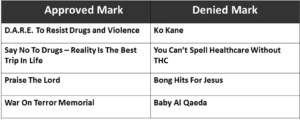U.S. Supreme Court Rules that “FUCT®” Is Fine
June 28, 2019 | Michael C. Cannata | Nancy A. Del Pizzo | Frank M. Misiti |Maybe you feel that the title to this bulletin is “immoral” or “scandalous,” or maybe you don’t. Either way, in light of the U.S. Supreme Court’s recent decision in Iancu v. Brunetti, whether a word or term is “immoral” or “scandalous” is no longer relevant to whether that word or term can receive federal trademark protection.
In a much anticipated decision authored by Justice Kagan on June 24, 2019, the Supreme Court held that the provision of the Lanham Act that barred the registration of “immoral” or “scandalous” trademarks (“the scandalous provision”) was unconstitutional.
As background, Erik Brunetti, the founder of the “FUCT” clothing brand, filed a trademark application to register FUCT in connection with clothing apparel. In January 2013, the U.S. Patent and Trademark Office (“USPTO”) issued a final rejection of the application on the grounds that the mark consisted of immoral or scandalous matter. Thereafter, Brunetti requested reconsideration of the final rejection, and also appealed to the Trademark Trial and Appeal Board (“TTAB”). The request for reconsideration was denied, and the TTAB affirmed the USPTO’s final rejection.
In September 2014, Brunetti appealed the TTAB’s decision to the Court of Appeals for the Federal Circuit (“Federal Circuit”). The Federal Circuit affirmed the TTAB’s decision, finding that there was substantial evidence supporting the conclusion that the FUCT mark “comprised immoral or scandalous matter.” But the Federal Circuit concluded that the scandalous provision “is an unconstitutional restriction of free speech” and therefore “reversed the [TTAB’s] holding that Mr. Brunetti’s mark is unregistrable.” The Federal Circuit determined that the scandalous provision “impermissibly discriminates based on content in violation of the First Amendment.”
Since the Federal Circuit invalidated a federal statute, the Supreme Court decided to review the Federal Circuit’s decision. In doing so, the Supreme Court looked to its previous decision in Matal v. Tam and concluded that the scandalous provision – – much like the disparagement provision that was declared unconstitutional in Tam – – violated the First Amendment. Specifically, the Supreme Court reasoned that the scandalous provision discriminated based on viewpoint because it disfavored certain ideas.
In its decision, the Supreme Court highlighted several instances where the USPTO engaged in such discrimination by approving certain trademarks and denying others. For example:
After underscoring these examples, the Supreme Court asked the hypothetical question: “How, then, can the Government claim that the ‘immoral or scandalous bar’ bar is viewpoint-neutral?” Answer: They cannot. In determining that the scandalous provision violated the First Amendment, the Supreme Court held that:
“There are a great many immoral and scandalous ideas in the world (even more than there are swearwords), and the Lanham Act covers them all.”
Thus, the pathway to securing federal protection for trademarks that may be considered “immoral” or “scandalous” is now less encumbered. The question remains, however, how many businesses will avail themselves of this pathway?
- Michael C. Cannata
- Nancy A. Del Pizzo
- Frank M. Misiti






